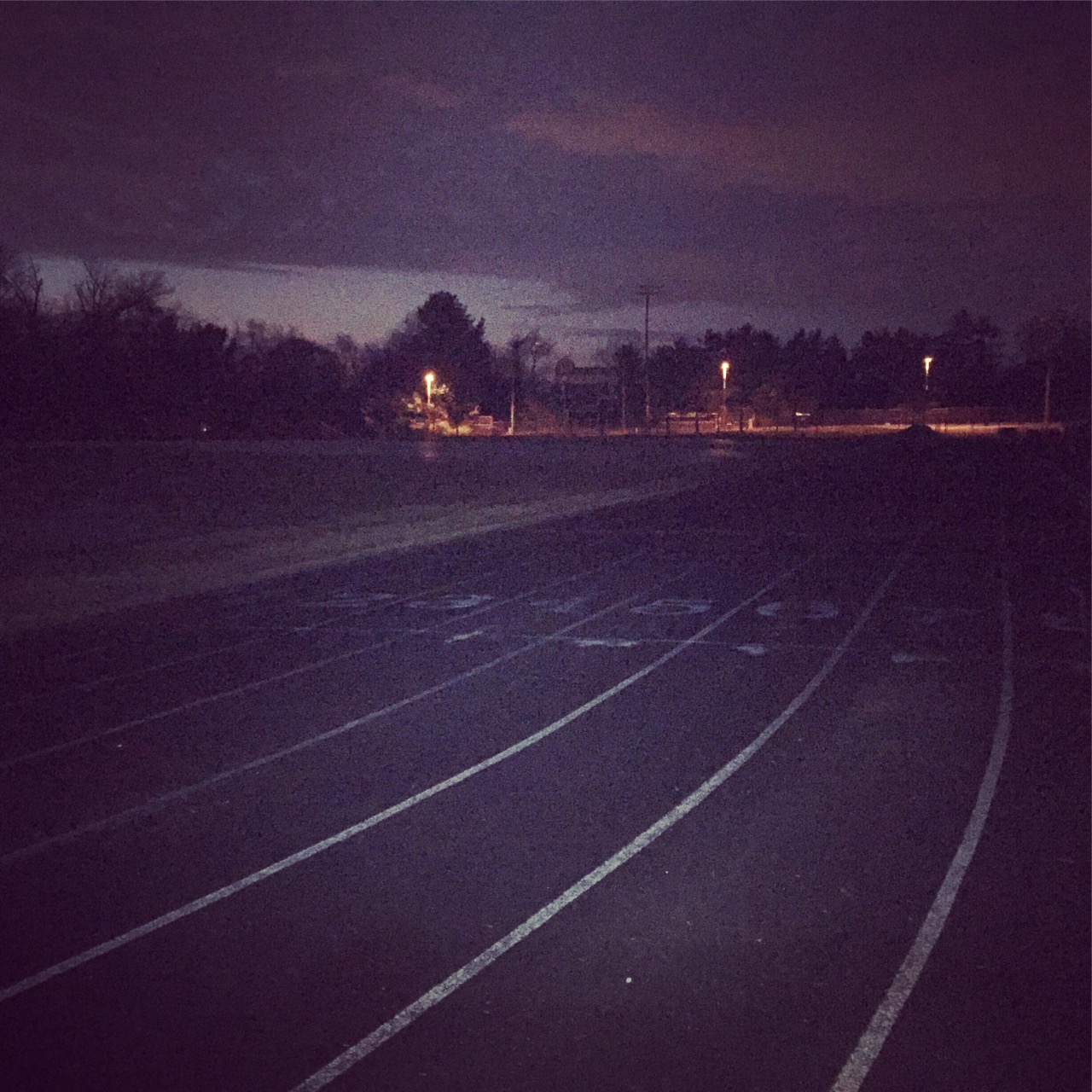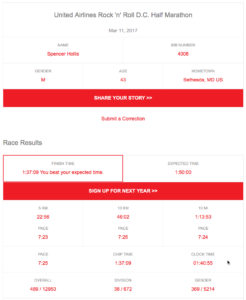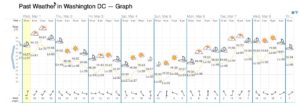This is a spectacular event. The ‘Festival’ includes a 5k on Saturday morning, followed by three separate categories–marathon, half-marathon and 10k on Sunday all run simultaneously. It’s relatively flat, cool, and well-run. Not a huge spectator turnout, but for the chance to run down the Rehoboth Boardwalk (twice) and to barrel through a beautiful State park…it’s wonderful. It’s THE race for those looking to tick Delaware off of their 50-State challenge list.
There’s races for fun, and races for time. You have to know which is which going into it as the planning and mindset are totally different during the weeks before the race and the start prep. This was to be a fun race; it was a chance for my family to come to Rehoboth Beach a bit before the season starts to just enjoy it without all the hubbub of Funland and the craziness of the crowds. Unfortunately, the elementary school talent show was scheduled for the same weekend, so it went from a nice family weekend to a ‘dad goes to the beach by himself for a weekend’ weekend.
Probably best that way in hindsight, as Rehoboth off-season is a shadow of Rehoboth in-season. Very few things are open, it was chilly and damp, so the beach wasn’t really an option, and we were in a hotel instead of our usual condo, so space was a bit limited. Even the hotel pool was cold (it never dawned on me that it wasn’t heated, warm as it is during the Summer).
In any case the race would go on, and I was running it as my Spring marathon. Registration was flawless, and I decided to enter both the marathon and the 5k as a warm-up race the day before. Normally, I’ll run an easy 5-10k before a marathon to loosen everything up, so this was on-schedule. The weather forecast was daunting: 50 degree highs and heavy rain forecasted all weekend. Yuck.
Saturday morning was indeed rainy as I made my way from Rehoboth to Dewey, a 10 minute drive. The bib pick up and expo were in a small conference center off of Route 1 and was quick and efficient. On a side note, the expo had a few interesting vendors and I managed to pick up two pairs of trainers in my style and size for half-price. Both were slightly used (part of their return policy), but couldn’t pass them up. The only downside is that I couldn’t either get a refund or transfer the marathon ‘after-party’ pass I purchased for the Mrs. They were strict on ID there and then and a wristband that we’d have to wear for 24 hours. Wish there was another way.
The rain stopped briefly for the 5k. ‘Don’t run hard,’ I kept telling myself. ‘This is just a warm-up run.’ Dammit. I got caught up in the excitement of the start. It was chip-timed, and really came off like a very professionally run race (which it was). Also, you start out and make a left turn 50 yards after the start. It seemed very treacherous after the rain as everything was wet, water had pooled there, and I had slipped on the road striping on my way to the start. Finally, I told myself to run the first mile, then back off and coast through the last two.
If it hasn’t come through in this blog yet, this is proof that I’m an idiot. I shot out of the start like a cannon. First mile was 5:40. The race has a turnaround at the midway point, so I could see who was in front of me. I hit the turn at 9:34 and there couldn’t have been more than 10 people in front of me at that turn, so I kept going. Second mile, 6:00. My legs were starting to feel it, but damn, I was in the front group and there were prizes for the top three in each age group. Screw it…keep running hard. Final chip time was 19:59–my first sub-20-minute 5k (yes barely, but it still counts!). Gun time was 20:08 (which was due to a wheelchair racer getting a 10-second head start on the field.
They had a brief award ceremony and I was chuffed to learn that I had WON the Male Masters (over 40) category. My first running win in any category ever. I took home a nice trophy, a glass window (sun-catcher) medallion, and the race medal.
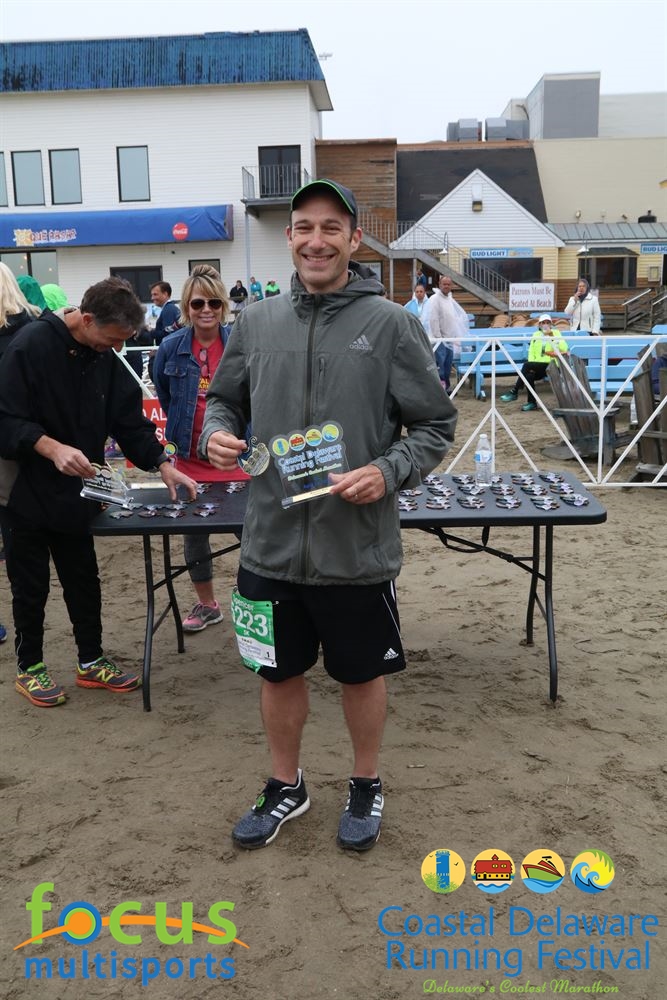
Next challenge was how to find a one-day recovery so that tomorrow wouldn’t be awful. Started off with a light swim in the hotel’s freezing pool, then a hot shower, stretching and nap. It was a very easy Saturday of reading, watching Lionel Messi dominate the El Classico, and having some sensible meals.
Sunday morning came early and it was pouring when I left the room. This was not going to be a good day if this kept up. Temperature was in the 40s, which was chilly, but the rain, oh boy. I don’t love running in the rain. Much of the course is trail-based (crushed stone), so I pictured it being a muddy mess too.
The start line was about 5 miles away from the finish, so they had shuttle busses to get you there. Well coordinated…plenty of space. The start itself was freezing. While the rain had stopped, it was on an exposed coastal lot, and the cold wind was howling. We were freezing our asses off, huddled around the down-wind side of a WWII-era guard tower (the namesake of the Tower Challenge, which is a separate prize for completing the 5k and Marathon). There was a “VIP Package” option available during registration that gave you access to the inside bathrooms and lounge area. This is the only time I’ve ever regretted not springing for that. It was that cold. I’d planned on ditching my jacket, but no way Jose…it was staying put. I was wishing I had gloves too.
The start was very laid back. No real waves as there were under 750 marathoners (the half-marathon group went out a half-hour or so later). There were pacers, which was a nice touch. I decided to stick myself in between the 3:30 and 3:45 pacers with the plan that I’d start with the front group and end with the back. After the 5k the day before, my expectations were low.
We started out down the driveway from the park area and made a quick turn onto Route 1. The road wasn’t closed, but a lane was, so there was ample room on the right side of the road for us. I never felt in danger in any way, and though we were a bit tight for the first mile or so, it opened up quickly. We were only on Route 1 for 1.75 miles before heading into Rehoboth and toward the boardwalk.
The boardwalk run was a trip. Having spent each of the last 10 or so summers there, it was fun to run past all of the landmarks. A good crowd had come out in the early morning, so there was excellent support. It had warmed up enough that I had planned to strip off my jacket at the end of the boardwalk (unsheltered from the coastal wind) and either tie it around my waist or even leave it near my hotel to pick up later.
As we headed into the Gordon’s Pond area, a path I’ve run numerous times on holiday, I was feeling surprisingly strong. To use this race to qualify for Boston, I would have to run under 7:20 per mile. I was right there at each split: 7:18, 7:12, 7:13, 7:14.
At the half-way point, which is near Lewes, Delaware, I was in excellent shape with a 1:34 time and a 7:14 average per-mile split. That stretch is probably the toughest on the course, as there’s a steady climb over the bridge for the Intercoastal Waterway near the Lewes Ferry dock. No cover from the wind, no cover from the sun (and the sun had peeked out at this point). It wasn’t even very scenic. Just a slog up the hill. I was determined, at that point, to keep going as long as I could at that pace.
Mile 16 was the breaking point. I felt my legs going and couldn’t sustain the earlier pace. I slowed down massively to 8 minutes per mile, just hoping I could catch a second wind and not give up all of the extra time I had banked from my fast start.
The trip back down the boardwalk wasn’t as exhilarating as the trip out, though the crowd had grown and that part was pretty motivating. From there, it’s back to Route 1 and a real battle to the finish. This is where the prior day’s 5k really came back to bite me as I just had nothing left in the tank. The only saving grace is that I never saw the 3:30 pacer, so I knew I was ahead of that pace. If I could just beat him to the line, I’d be good.
Sure enough, I limped over the line at 3:27:27–shattering my PR by 30 minutes and giving me hope for a BQ at some point in my life. In September, my qualifying time goes from under 3:15 to under 3:25, so this was close…had I already had a 3:25 target, I’m pretty sure I could have found the extra time here, but there was no way I was getting under 3:15 on this morning (and, for those who don’t know, you have to get considerably under the time to get into the race…usually about 2.5 minutes under as they take the fastest qualified runners in each age group).
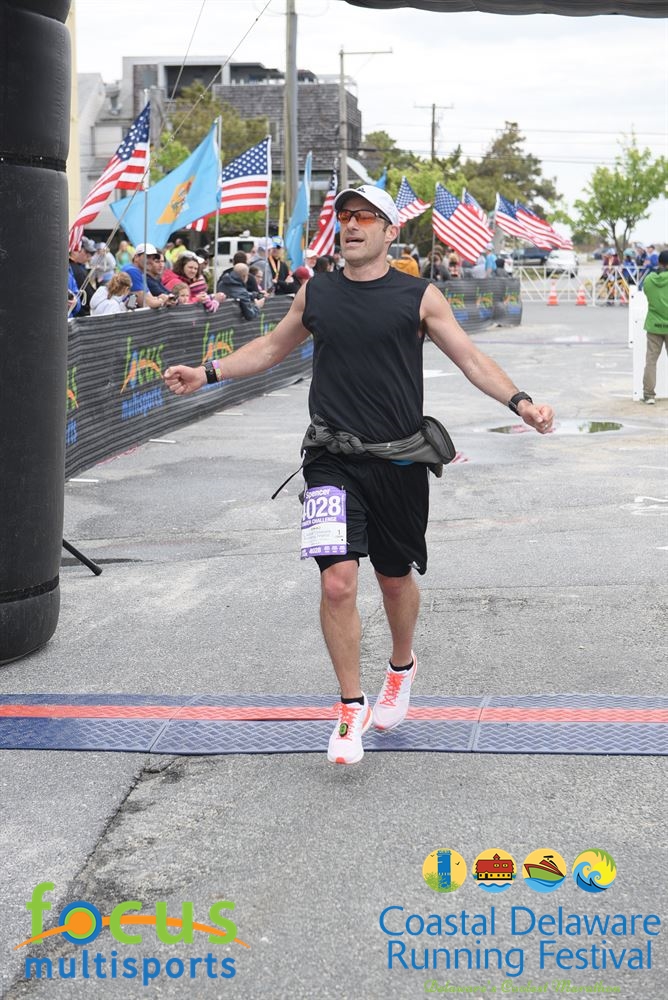
The finish was at the 5k start, so there was a sharp right turn and 50 yards to the banner. A good crowd had arrived at the end and I found the strength to run over the finish (always…where does that come from???). I received my medals (finisher and challenge medal) and took part in the nice banquet-like spread, where I met some very nice fellow runners: One couple in their 50s who were going for the 50-State challenge. One guy who literally blanked out a mile from the end and was carried over the line by some spectators. One woman who was devastated not to hit her BQ time, even though she had just run a race in Virginia Beach two weeks before (that’s not enough recovery time from a marathon btw). One guy from New Jersey who was running his second marathon and was thrilled with his 4:45 time (yay! happy for him!). It was really the most social post-race thing I’ve ever been a part of, helped by the free beer, the fact that it was inside, and there were tables and chairs (and stools), which promoted socializing.
Overall, while I was a bit disappointed to have come so close to a BQ time, I was proud of my accomplishments on both days and felt like I had achieved the pinnacle of my fitness level after 7 years of training. It was one of the most gratifying sports-related weekends of my life.
One other bonus: Free race photos. Awesome.
Full points to Focus Multisports who put this race together. It was very well organized, and will go down as one of my favorite races. I highly recommend it for anyone looking for a Boston time in the Mid-Atlantic area–it’s what you’re looking for: Fast, Flat, Cool, and well organized. A no-stress trip to the beach for a run.
